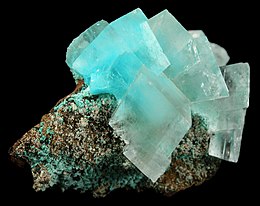
Hemimorphite is the chemical compound Zn4(Si2O7)(OH)2·H2O, a component of mineral calamine. It is a silicate mineral which, together with smithsonite (ZnCO3), has been historically mined from the upper parts of zinc and lead ores. Both compounds were originally believed to be the same mineral and classified as calamine. In the second half of the 18th century, it was discovered that these two different compounds were both present in calamine. They closely resemble one another.

Bornite, also known as peacock ore, is a sulfide mineral with chemical composition Cu5FeS4 that crystallizes in the orthorhombic system (pseudo-cubic).
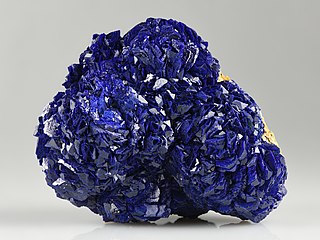
Azurite is a soft, deep-blue copper mineral produced by weathering of copper ore deposits. During the early 19th century, it was also known as chessylite, after the type locality at Chessy-les-Mines near Lyon, France. The mineral, a basic carbonate with the chemical formula Cu3(CO3)2(OH)2, has been known since ancient times, and was mentioned in Pliny the Elder's Natural History under the Greek name kuanos (κυανός: "deep blue," root of English cyan) and the Latin name caeruleum. Copper (Cu2+) gives it its blue color.
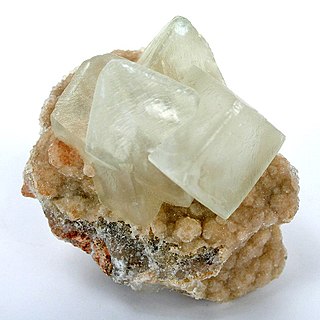
Smithsonite, also known as zinc spar, is the mineral form of zinc carbonate (ZnCO3). Historically, smithsonite was identified with hemimorphite before it was realized that they were two different minerals. The two minerals are very similar in appearance and the term calamine has been used for both, leading to some confusion. The distinct mineral smithsonite was named in 1832 by François Sulpice Beudant in honor of English chemist and mineralogist James Smithson (c. 1765–1829), who first identified the mineral in 1802.

Hydrozincite, also known as zinc bloom or marionite, is a white carbonate mineral consisting of Zn5(CO3)2(OH)6. It is usually found in massive rather than crystalline form.

Cuprite is an oxide mineral composed of copper(I) oxide Cu2O, and is a minor ore of copper.

Adamite is a zinc arsenate hydroxide mineral, Zn2AsO4OH. It is a mineral that typically occurs in the oxidized or weathered zone above zinc ore occurrences. Pure adamite is colorless, but usually it possess yellow color due to Fe compounds admixture. Tints of green also occur and are connected with copper substitutions in the mineral structure. Olivenite is a copper arsenate that is isostructural with adamite and there is considerable substitution between zinc and copper resulting in an intermediate called cuproadamite. Zincolivenite is a recently discovered mineral being an intermediate mineral with formula CuZn(AsO4)(OH). Manganese, cobalt, and nickel also substitute in the structure. An analogous zinc phosphate, tarbuttite, is known.

Tetrahedrite is a copper antimony sulfosalt mineral with formula: (Cu,Fe)
12Sb
4S
13. It is the antimony endmember of the continuous solid solution series with arsenic-bearing tennantite. Pure endmembers of the series are seldom if ever seen in nature. Of the two, the antimony rich phase is more common. Other elements also substitute in the structure, most notably iron and zinc, along with less common silver, mercury and lead. Bismuth also substitutes for the antimony site and bismuthian tetrahedrite or annivite is a recognized variety. The related, silver dominant, mineral species freibergite, although rare, is notable in that it can contain up to 18% silver.

Stannite is a mineral, a sulfide of copper, iron, and tin, in the category of thiostannates.

Enargite is a copper arsenic sulfosalt mineral with formula Cu3AsS4. It takes its name from the Greek word enarge, "distinct". Enargite is a steel gray, blackish gray, to violet black mineral with metallic luster. It forms slender orthorhombic prisms as well as massive aggregates. It has a hardness of 3 and a specific gravity of 4.45.

Austinite is a member of the adelite-descloizite group, adelite subgroup, the zinc (Zn) end member of the copper-Zn series with conichalcite. It is the zinc analogue of cobaltaustinite and nickelaustinite. At one time “brickerite” was thought to be a different species, but it is now considered to be identical to austinite. Austinite is named in honour of Austin Flint Rogers (1877–1957), American mineralogist from Stanford University, California, US.

Descloizite is a rare mineral species consisting of basic lead and zinc vanadate, (Pb, Zn)2(OH)VO4, crystallizing in the orthorhombic crystal system and isomorphous with olivenite. Appreciable gallium and germanium may also be incorporated into the crystal structure.
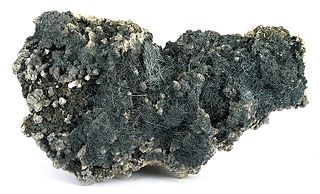
Boulangerite is an uncommon monoclinic orthorhombic sulfosalt mineral, lead antimony sulfide, formula Pb5Sb4S11. It was named in 1837 in honor of French mining engineer Charles Boulanger (1810–1849), and had been a valid species since pre-IMA. It was first described prior to 1959, and is now grandfathered.

Sauconite is a complex phyllosilicate mineral of the smectite clay group, formula Na0.3Zn3(SiAl)4O10(OH)2·4H2O. It forms soft earthy bluish white to red-brown monoclinic crystals typically massive to micaceous in habit. It has a Mohs hardness of 1 to 2 and a specific gravity of 2.45. Optically it is biaxial positive with refractive index values of nα = 1.550 – 1.580, nβ = 1.590 – 1.620 and nγ = 1.590 – 1.620. It is found in vugs and seams in the oxidized zones of zinc and copper deposits. It occurs in association with hemimorphite, smithsonite, chrysocolla, coronadite and various iron oxides.
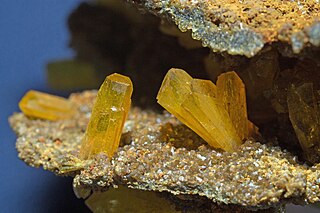
Legrandite is a rare zinc arsenate mineral, Zn2(AsO4)(OH)·(H2O).

Rosasite is a carbonate mineral with minor potential for use as a zinc and copper ore. Chemically, it is a copper zinc carbonate hydroxide with a copper to zinc ratio of 3:2, occurring in the secondary oxidation zone of copper-zinc deposits. It was originally discovered in 1908 in the Rosas mine in Sardinia, Italy, and is named after the location. Fibrous blue-green rosasite crystals are usually found in globular aggregates, often associated with red limonite and other colorful minerals. It is very similar to aurichalcite, but can be distinguished by its superior hardness.

A native metal is any metal that is found pure in its metallic form in nature. Metals that can be found as native deposits singly or in alloys include aluminium, antimony, arsenic, bismuth, cadmium, chromium, cobalt, indium, iron, manganese, molybdenum, nickel, niobium, rhenium, selenium, tantalum, tellurium, tin, titanium, tungsten, vanadium, and zinc, as well as the gold group and the platinum group. Among the alloys found in native state have been brass, bronze, pewter, German silver, osmiridium, electrum, white gold, silver-mercury amalgam, and gold-mercury amalgam.
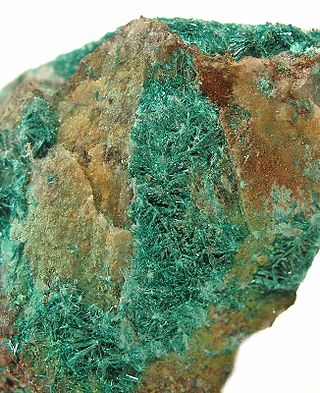
Botallackite, chemical formula Cu2(OH)3Cl is a secondary copper mineral, named for its type locality at the Botallack Mine, St Just in Penwith, Cornwall. It is polymorphous with atacamite, paratacamite and clinoatacamite.
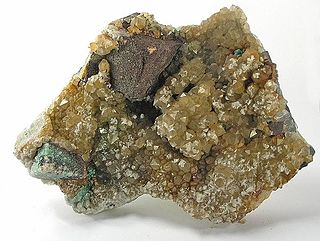
Plattnerite is an oxide mineral and is the beta crystalline form of lead dioxide (β-PbO2), scrutinyite being the other, alpha form. It was first reported in 1845 and named after German mineralogist Karl Friedrich Plattner. Plattnerite forms bundles of dark needle-like crystals on various minerals; the crystals are hard and brittle and have tetragonal symmetry.

Marshite (CuI) is a naturally occurring isometric halide mineral with occasional silver (Ag) substitution for copper (Cu). Solid solution between the silver end-member miersite and the copper end-member marshite has been found in these minerals from deposits in Broken Hill, Australia. The mineral's name is derived from the person who first described it, an Australian mineral collector named Charles W. Marsh. Marsh drew attention to native copper iodide (Marshite) in the 1800s emphasizing its natural occurrence, it is not to be confused with copper (I) iodide a substance commonly synthesized in laboratory settings.
